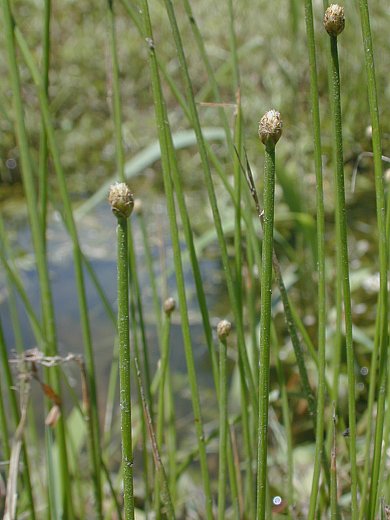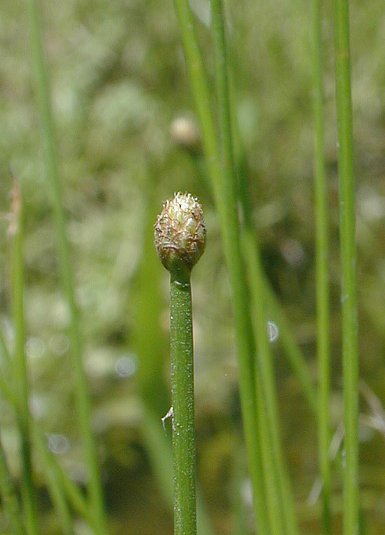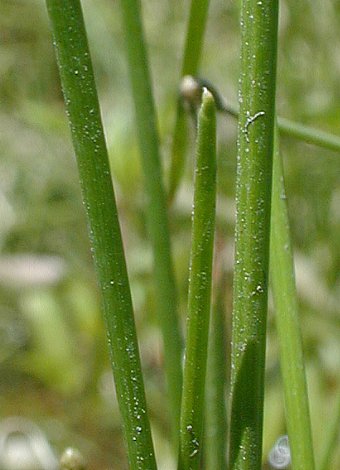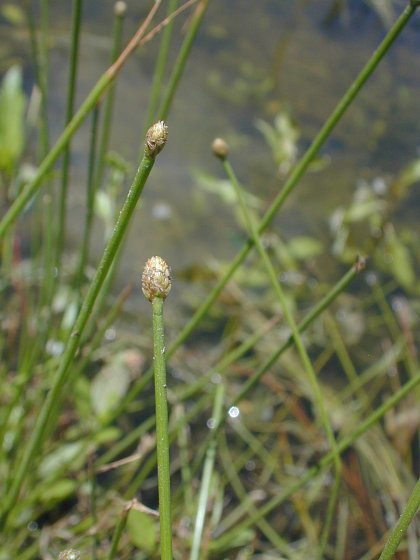Description: This plant is a summer annual about 2-10" tall. Each plant produces a single culm or a tuft of culms. Each culm is green, hairless, circular in cross-section (terete), and unbranched. The leaves are reduced to a single sheath at the base of the culm; there are no leaf blades. This sheath is brown and rough-textured; there is often a single tooth along its upper rim. The culm terminates in a small flowerhead about 4-10 mm. long and 3-5 mm. across. This flowerhead is ovoid in shape with a blunt tip that consists of many overlapping scales that are appressed together. These scales are about 2 mm. long, whitish green to brown, oval to ovate in shape, and slightly convex along their outer surfaces; their margins are often chaffy. Hidden by these scales are inconspicuous flowers that lack petals and sepals (one flower per scale). Each of these flowers consists of an ovary with a divided style (either bipartite or tripartite) and usually 3 stamens.

The blooming period occurs during the summer, lasting about 1-2 weeks for a colony of plants. The flowers are cross-pollinated by the wind. Afterwards, the flowers are replaced by achenes (one achene per flower). These achenes are about 1 mm. long and a little less across; their bodies are light brown to brown and obovoid in shape. At the apex of the body of each achene, there is a flattened-conical tubercle that is more broad than it is tall. This tubercle is much shorter in length than the achene's body, but almost as broad, and it is a lighter shade of brown. At the apex of this tubercle, there is a short beak that corresponds to a basal remnant of the style. Each achene is usually surrounded by 5-7 fine bristles that originate from the achene's base; these bristles are about the same length as the achene (a 10x hand lens is useful in observing these bristles and other characteristics of the achene). The root system is fibrous. This plant spreads by reseeding itself and it often forms colonies.

Cultivation:
The
preference is full sun and wet conditions; shallow water is readily
tolerated. This plant can flourish in different kinds of soil,
including those that are sandy, gravelly, or mucky. It doesn't tolerate
much competition from Typha spp. (Cattails) and
other tall wetland species.
Range & Habitat:
The native Blunt Spikerush is occasional to locally common throughout
most of Illinois; it is less common or absent in the north-central
region (see Distribution
Map).
Habitats include marshes, fens, gravelly
seeps, interdunal flats, sedge meadows, shorelines of lakes and ponds,
low-areas along rivers, drainage ditches, poorly drained fields, and
waste
areas that are prone to seasonal flooding. In urban areas,
Blunt Spikerush is occasionally found in wet grassy areas that are
subjected to occasional mowing from local landowners. This spikerush is
typically found in wetlands with a history of disturbance.

Faunal
Associations:
Spikerushes (Eleocharis
spp.) are host plants of several kinds of insects. This
includes the aphid Rhopalosiphum
cerasifoliae, leafhoppers (especially Limotettix spp.),
aquatic leaf beetles (Donacia
spp., Plateumaris
spp.), larvae of the shore fly Hydrellia tibialis,
and larvae of the Yellow-Collared Scape Moth (Cisseps fulvicollis).
The seedheads of spikerushes are eaten by ducks,
rails, and other wetland birds (see the Bird Table for a
listing of these species). The Canada Goose also eats the culms, while
the Muskrat eats the roots and sometimes other parts of these plants
(Martin et al., 151/1961; Hamerstrom & Blake,
1939). Dense stands of spikerushes along shorelines provide
cover for frogs and
abundant perching sites for damselflies and dragonflies.
Photographic Location:
A grassy drainage ditch that was occasionally mowed over by a local
landowner in Champaign, Illinois. Usually, this practice destroys most
wetland species, but Blunt Spikerush was able to thrive because of the
reduced competition from taller plants.

Comments: This is one of the shorter spikerushes (Eleocharis spp.). To many people, spikerushes look like grass, but they are actually sedges that consist of naked culms with single scaly flowerheads on top. As the common name suggests, the flowerhead of Blunt Spikerush is more blunt on top than those of many other spikerushes. Each of its achenes has a tubercle that is unusually flat and broad and there are several fine bristles surrounding the achene (usually about 6). Other spikerushes have tubercles that are more narrow and conical, or their achenes lack bristles. Mohlenbrock (2002) considers Blunt Spikerush to be a variety of Ovate Spikerush, or Eleocharis ovata obtusa, but it is more often regarded as a distinct species. Using Mohlenbrock's taxonomy, the other varieties of Ovate Spikerush differ by having more narrowly conical tubercles on the achenes (Eleocharis ovata ovata) and by having seedheads that are oblongoid, rather than ovoid, in shape (Eleocharis ovata detonsa).